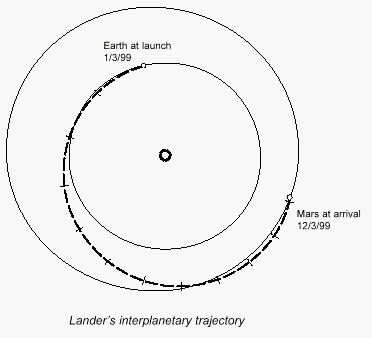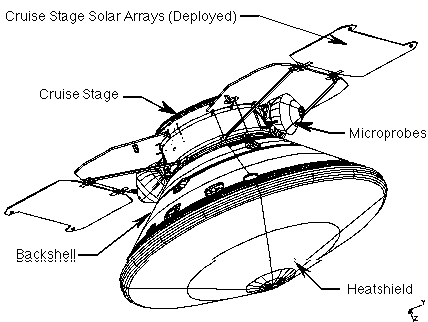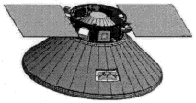

Mars Polar Lander - Cruise Phase

Mars Polar Lander's Interplanetary TrajectoryMars Polar Lander will spend 11 months in cruise, entering Mars' atmosphere December 3, 1999. The spacecraft's flight path is called a Type 2 trajectory because it will take the lander more than 180 degrees around the Sun, enabling it to target a landing zone near Mars' south pole. By comparison, Mars Pathfinder followed a Type 1 trajectory which took it less than 180 degrees around the Sun, reaching Mars in only seven months. During the first leg of its trip, Mars Polar Lander will fly slightly inward toward the Sun before spiralling out beyond Earth's orbit to Mars. Toward the end of cruise, it will fly slightly out past the orbit of Mars before returning inward to intersect the planet's orbit.

Mars Polar Lander In Cruise ConfiguationThroughout cruise, the spacecraft will communicate with Earth using its X-band transmitter and the medium-gain horn antenna on the cruise stage. During the first 30 days after launch, the spacecraft will be tracked from 10 to 12 hours per day. During quiet phases of the flight, when spacecraft operations are at a minimum, one four-hour tracking session per day will be conducted.
Forty-five days before Mars arrival, tracking will be increased. At least three four-hour sessions per day will be required for high-precision navigation, with continuous tracking when possible. Thirty days before arrival, nearly continuous tracking sessions will switch off between Mars Polar Lander and either Mars Climate Orbiter or the currently orbiting Mars Global Surveyor in order to fine-tune the lander's final approach to Mars.

The Mars Polar Lander SpacecraftDuring interplanetary cruise, Mars Polar Lander is scheduled to fire its thrusters in up to six maneuvers to adjust its flight path. The first of these trajectory correction maneuvers will be carried out 15 days after launch. This maneuver, expected to be the largest and longest, will correct for injection errors and adjust the Mars arrival aimpoint. The maneuver is expected to take up to five minutes to execute.
The remaining trajectory correction maneuvers are expected to be smaller. They are scheduled 45 days after launch (February 17); 60 days before Mars arrival (about October 4); and 10 days before arrival (about November 23). A final contingency maneuver can be conducted if necessary from three days to seven hours before the spacecraft hits the upper atmosphere of Mars.
Science instruments will be tested and calibrated during two week-long periods scheduled during cruise. The first is planned 40 days after launch (February 12) The second is scheduled 90 days before arrival (about September 4).
Science instrument checkout data and spacecraft engineering data gathered during the cruise will be transmitted to Earth via the Deep Space Network's 70-meter-diameter (230-foot) antennas. Use of these large dish antennas will allow ground controllers to receive data at higher data rates than possible with the smaller 34-meter (112-foot) antennas.
The meteorological package's pressure transducer will be powered on for a few minutes each month during cruise for calibration. The surface stereo imager will twice take images of dark space inside the lander's aeroshell during cruise to calibrate its charge-coupled device (CCD) detectors.
Entry, Descent And Landing Phase
| Home | Mars Polar Lander | Deep Space 2 Microprobes | Mars Climate Orbiter |
| Welcome | Mailing List | Links | Credits |
For questions or comments on this website please refer to our list of contacts.